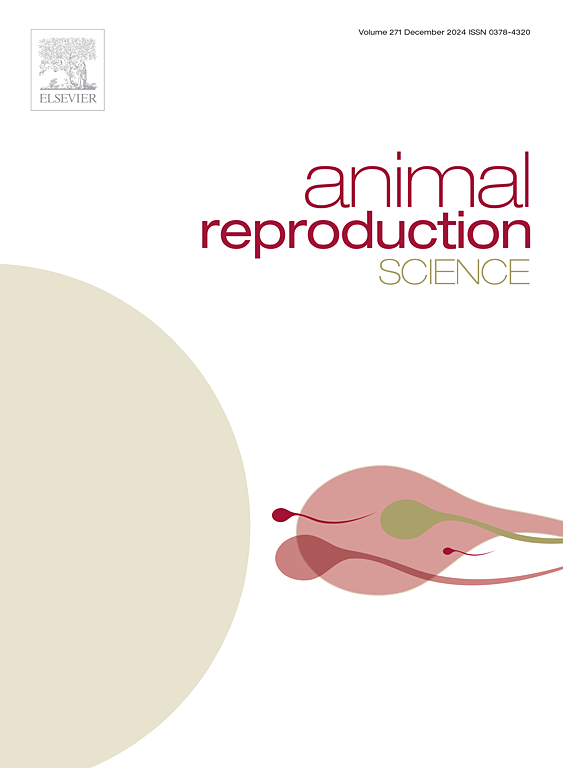Herbicide exposure impairs the morphofunctional parameters of bovine sperm
IF 3.3
2区 农林科学
Q1 AGRICULTURE, DAIRY & ANIMAL SCIENCE
引用次数: 0
Abstract
Glyphosate (GLP), 2,4-dichlorophenoxyacetic acid (2,4-D), and atrazine (ATZ) are the most commercialized herbicides in Brazil. Despite the damage to male fertility caused by pesticides, information on cattle remains limited. We evaluated the effects of exposing bovine sperm to concentrations of GLP, 2, 4-D, and ATZ. A semen pool from four bulls was incubated at 37°C for 1 and 3 h in TALP-Fert medium, and treated as follows: Control group (vehicle dimethyl sulfoxide); GLP at 5 (G5), 36 (G36), and 50 (G50) µg/mL; 2,4-D, at 0.5 (D05), 1 (D1), and 5 (D5) µM; and ATZ, at 0.05 (A005), 0.1 (A01), and 1 (A1) µM. Herbicide groups affected various kinematic parameters. Total motility was reduced by ATZ, while progressive motility decreased in all treatments compared to the control. Velocity-related kinematic parameters were significantly impaired by GLP treatment, and hyperactivity was negatively influenced by all three herbicide groups. Sperm morphology was altered in the G50, D5, and ATZ groups, with a higher incidence of major defects compared to the control. The hypo-osmotic swelling test revealed that plasma membrane integrity was compromised only in the A005 and A01 treatment groups. Regarding oxidative stress markers, although no differences were observed in reactive oxygen species generation or lipid peroxidation, total antioxidant capacity was significantly reduced by the 2,4-D treatment. Moreover, fertilization rates declined in the D05 group, which corresponded to the lowest 2,4-D concentration. These findings demonstrate that herbicide concentrations can adversely affect bovine spermatozoa by impairing critical quality parameters, ultimately compromising sperm function.
除草剂暴露会损害牛精子的形态功能参数。
草甘膦(GLP)、2,4-二氯苯氧乙酸(2,4- d)和阿特拉津(ATZ)是巴西商业化程度最高的除草剂。尽管农药对男性生育能力造成了损害,但关于牛的信息仍然有限。我们评估了牛精子暴露于GLP、2,4 - d和ATZ浓度的影响。选取4头公牛的精液池,在TALP-Fert培养基中于37°C孵育1和3 h,处理如下:对照组(二甲基亚砜);GLP浓度为5 (G5)、36 (G36)、50 (G50)µg/mL;2,4- d, 0.5 (D05), 1 (D1), 5 (D5)µM;和ATZ分别为0.05 (A005)、0.1 (A01)和1 (A1)µM。除草剂基团对各运动参数有影响。与对照组相比,ATZ降低了总运动性,而所有治疗的进行性运动性均下降。GLP处理显著损害了与速度相关的运动学参数,三种除草剂组均对多动性产生负面影响。G50、D5和ATZ组的精子形态发生了改变,与对照组相比,主要缺陷的发生率更高。低渗透肿胀试验显示,只有A005和A01处理组的质膜完整性受到损害。在氧化应激标志物方面,尽管在活性氧生成和脂质过氧化方面没有观察到差异,但2,4- d处理显著降低了总抗氧化能力。D05组受精率下降,对应于最低的2,4- d浓度。这些发现表明,除草剂浓度可以通过损害关键质量参数对牛精子产生不利影响,最终损害精子功能。
本文章由计算机程序翻译,如有差异,请以英文原文为准。
求助全文
约1分钟内获得全文
求助全文
来源期刊

Animal Reproduction Science
农林科学-奶制品与动物科学
CiteScore
4.50
自引率
9.10%
发文量
136
审稿时长
54 days
期刊介绍:
Animal Reproduction Science publishes results from studies relating to reproduction and fertility in animals. This includes both fundamental research and applied studies, including management practices that increase our understanding of the biology and manipulation of reproduction. Manuscripts should go into depth in the mechanisms involved in the research reported, rather than a give a mere description of findings. The focus is on animals that are useful to humans including food- and fibre-producing; companion/recreational; captive; and endangered species including zoo animals, but excluding laboratory animals unless the results of the study provide new information that impacts the basic understanding of the biology or manipulation of reproduction.
The journal''s scope includes the study of reproductive physiology and endocrinology, reproductive cycles, natural and artificial control of reproduction, preservation and use of gametes and embryos, pregnancy and parturition, infertility and sterility, diagnostic and therapeutic techniques.
The Editorial Board of Animal Reproduction Science has decided not to publish papers in which there is an exclusive examination of the in vitro development of oocytes and embryos; however, there will be consideration of papers that include in vitro studies where the source of the oocytes and/or development of the embryos beyond the blastocyst stage is part of the experimental design.
 求助内容:
求助内容: 应助结果提醒方式:
应助结果提醒方式:


